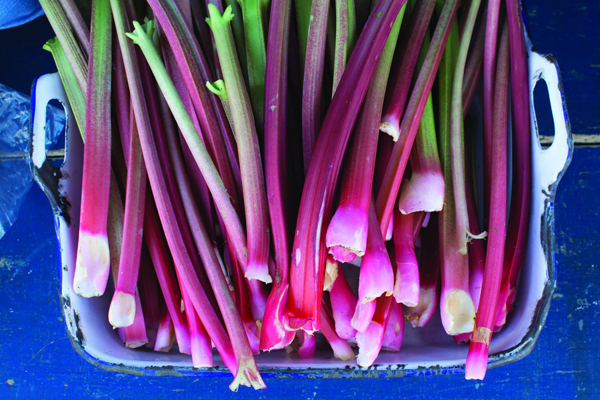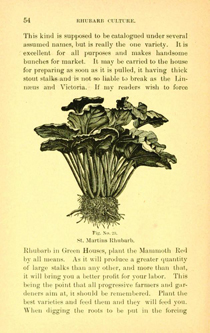 Photo by Lynn Karlin. Rhubarb has long been a star of the spring garden, with both medicinal and gastronomical applications.
Photo by Lynn Karlin. Rhubarb has long been a star of the spring garden, with both medicinal and gastronomical applications.
By Sandra L. Oliver
Few people are ambivalent about rhubarb. Most either love this hardy vegetable with its tall reddish stalks capped by large green leaves, or they turn their heads, puckering into an expression of dislike.
One of my friends recalls with pleasure how as a child she pulled up rhubarb stalks raw and ate them dipped in sugar. Another friend, who still doesn’t like rhubarb, remembers with distaste the odd sensation it created in his mouth—he describes it as “gritting my teeth.” Nonetheless, rhubarb is cropping up in trendy cookbooks and food magazines, roasted with baby beets, chopped and braised with chicken, or served in a more traditional way as a dessert.
Maybe rhubarb is poised to replace kale as the next hip vegetable, as one friend argues. Maybe not. One thing on which we all can agree, though, is that rhubarb is not native to North America. Originally medicinal rhubarb came from China and for many years in the 1700s was a valued export from Russia. One story goes that rhubarb seeds were first cultivated in this country in the 1790s, by an unnamed Mainer who then introduced it to farmers in Massachusetts. But John Bartram, an early Quaker horticulturalist, was growing at least two varieties of the plant in the 1730s, and Benjamin Franklin sent Bartram seeds for yet another variety in the 1770s from London, according to Joel Fry, curator at Bartram’s Garden in Philadelphia. However it got here, rhubarb is a tough perennial; along with some humans, deer and woodchucks don’t eat it. It is one of the first edibles to appear in May, with long red stalks ready for use in desserts and, increasingly, in the 21st century, in savory dishes. Most people know that the leaves are poisonous.
 Digitized image courtesy the Biodiversity Heritage Library. In 1894, Fred S. Thompson’s Rhubarb or Pie Plant Culture advised readers to “Plant the best varieties and feed them and they will feed you.”
Digitized image courtesy the Biodiversity Heritage Library. In 1894, Fred S. Thompson’s Rhubarb or Pie Plant Culture advised readers to “Plant the best varieties and feed them and they will feed you.”
No one pays attention to the roots any more. But it was those roots that were most prized for medicinal purposes as a purgative—that is, laxative. Dug, cut up, and dried, then made into a potion or tincture, rhubarb root was used medicinally by the ancient Chinese, Greeks, and Romans. English settlers brought medicinal rhubarb to America with them, and through the 1600s and 1700s nearly all references to rhubarb show a medical context. A list of medicinals available in New York City in 1690 included rhubarb, for example.
Rhubarb seeds started showing up in American catalogues in the 1820s, horticulturalist Victor Boswell wrote in an article for National Geographic in 1949. In the late 1700s, the Augusta, Maine, midwife and caregiver Martha Ballard cited it in her diary 23 times, using it 22 times as a medicinal and only once in a tart. Josiah Pierce, a Bowdoin College student, wrote home to his mother on June 16, 1846, saying, “I wish I had a little of your tincture of rhubarb this hot weather. I am getting dyspeptic,”—which means he suffered from digestive difficulties. By the 1700s, when vegetable growing was no longer a necessity for all households, especially those near urban centers that could rely on farmers’ markets, hobby gardening trickled into the more prosperous classes.
Gentlemen farmers in New England and through the Middle Atlantic states (like Thomas Jefferson), collected seeds and plants, and grew out specimens. These amateur horticulturalists did much of the introduction and gradual promotion of many vegetables, fruits, and, flowers in America. It might very well have been one such an unknown enthusiast who introduced rhubarb to Maine.
By the mid-1880s, the plant had become fairly common on this side of the Atlantic. In New York City, Thomas DeVoe, writing in his Market Assistant in 1867, reported, “The editor of the Commercial Advertiser, May 15, 1830, thus notices the introduction of this fine plant: ‘We can not forbear mentioning that Mr. William Neale (who kept a garden in Fifth-street, [sic] a few doors east of the Bowery) has a large supply of that choice vegetable, the rhubarb, now just coming into use in this country, as an esculent of excellent properties.’ ”
Even though rhubarb is really a vegetable, it is now categorized as a fruit by U.S. Customs because of its culinary use. It appears only occasionally in both English and American cookbooks in the early 1800s. Martha Ballard’s reference to rhubarb tart was typical of the fruit’s earliest use. On May 23, 1804, she wrote, “I roasted Veal for dinner, made Rhubarb tarts aftern[oon].”
But rhubarb, often called “pie-plant,” did not take off in popularity for another 50 years. Why? Lydia Maria Child gives us a big hint. The author of The American Frugal Housewife, published in 1833, she described how to make pie from “Persian Apple” or rhubarb, and explained, “These are dear pies, for they take an enormous quantity of sugar.” Refined sugar in the first half of the 1800s was costly, usually reserved for sweetening beverages and making preserves. As the 1800s progressed, increased production of cheap, granulated sugar made sweetening rhubarb less expensive.
Aside from a simple sauce of stewed rhubarb sweetened to taste and eaten with a spoon, pie was the primary use of rhubarb until the 20th century. Ida Baily Allen’s cookbook, printed in 1917, offered up “Rhubarb and Pineapple Dumplings” possibly made with the help of the Dole company test kitchen. By the 1940s and early 1950s, cookbooks suggested rhubarb and raisin pie, rhubarb and fig marmalade, brown betty, conserve, rhubarb and strawberries, bread pudding, and others.
In tune with the rest of the country’s use of rhubarb, Mainers favored it in pie until the mid-1900s. In Maine, the Independent Order of Oddfellows’ female branch, the Rebekahs, published a series of editions of the now-venerable Rebekahs’ Cook Book. Sure enough, they included rhubarb recipes. The 1925 edition dutifully provides one for pie; the 1939 version has a rhubarb custard pie; and the 1956 edition adds a recipe for rhubarb and orange marmalade. In 1969, Marjorie Standish, author of Cooking Down East, wrote recipes for rhubarb cake, coffee cake, crisp, chutney, juice, as well as pie and marmalade.
It’s going to take a lot to dislodge rhubarb pie, with or without strawberries, from its two-century-long dominance. Here is a recipe for delicious compote that may temp you.
Contributing Editor Sandra L. Oliver’s most recent book Maine Home Cooking: 175 Recipes from Down East Maine Kitchens (Down East Books, Rockport) was published in 2012.

Rhubarb Orange Compote 5 oranges 1 cup sugar ¼ cup water ¼ teaspoon cinnamon 4 cups rhubarb, cut into 1-inch pieces Cognac (optional)
Preheat oven to 350°.
With a very sharp small knife, cut six 1-inch julienne strips from the peel of one of the oranges, being careful not to get any of the white pith. Blanch the strips in boiling water for 5 minutes, drain, and cut them into slivers; set aside.
Squeeze the orange from which you have taken the strips plus one other. Pour the juice into a small saucepan and add to it the sugar and cinnamon and cook about 5 minutes until the sugar dissolves.
Put the rhubarb in an ovenproof glass dish. Distribute the reserved orange strips over the rhubarb and add the orange syrup. Cover the dish with a baking sheet or foil and bake for 20-25 minutes or until the rhubarb is tender but still whole. Let it cool.
Peel the remaining 3 oranges and cut into wedges, removing the membrane that separates the sections. Add the orange sections and Cognac (if you are using it) to the rhubarb. Chill. Makes six servings. Read more about the history of the rhubarb trade, plus a tart and tasty recipe from the York Historical Society. http://www.maineboats.com/print/issue-134/RhubarbMusings






